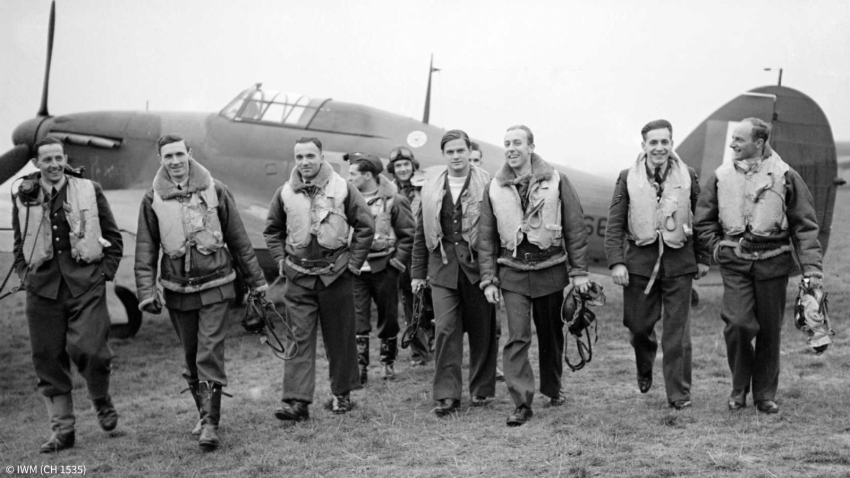In Part II of our Battle of Britain blog, we return to the photograph of 303 Squadron and explore the names behind the image. Read on to discover what we found in the records.
Mirosław “Ox” Ferić
World War II Index to Allied Airmen Roll of Honour, 1939-1945: Mirosław’s entry in the collection reveals that he was killed whilst flying on 14 February 1942. Having reached the rank of Flying Officer, the twenty-six-year-old’s Spitfire Mk. Vb broke up in a dive and crashed on Northolt Airfield during a training flight. Mirosław was buried in Northwood Cemetery, London and was the holder of the following Polish awards: the War Order of Virtuti Militari and the Cross of Valour.
Royal Air Force Operations Record Books: ‘14 February 1942. A fatal accident in the morning. F/O M. Ferić on his first flight since being N.E. dived into the taxi track near the Squadron dispersal. It seemed that part of the wing broke away and it swung round breaking off the tail of the aircraft at approximately 5,000 feet and the aircraft dived straight into the ground to a depth of about 6 feet.’
John A. Kent “Kentowski”
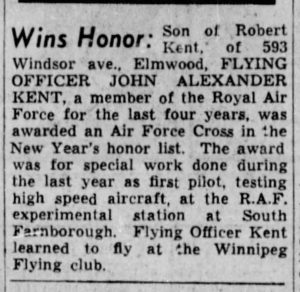
The Winnipeg Tribune, 3 January 1939: ‘Wins Honour: Son of Robert Kent, of 593 Windsor ave., Elmwood, Flying Officer John Alexander Kent, a member of the Royal Air Force for the last four years, was awarded an Air Force Cross in the New Year’s honour list. The award was for special work done during the last year as first pilot, testing high-speed aircraft at the R.A.F. experimental station at South Farnborough. Flying Officer Kent learned to fly at the Winnipeg Flying Club.’
UK, WWII, London Gazette, Military Notices, 1939-1945: ‘Early in October 1940, this officer, when entirely alone, attacked 40 Messerschmitt 109s and shot down two of them. He has personally destroyed at least four enemy aircraft. Flight Lieutenant Kent has been responsible in a large measure for the fighting efficiency of his squadron and has materially contributed to its success. He has proved himself a born leader.’ Awarded the Distinguished Flying Cross.
UK, WWII, London Gazette, Military Notices, 1939-1945: Acting Squadron Leader, awarded the War Order of Virtuti Militari, 5th Class. Conferred by the Polish Government.
UK, WWII, London Gazette, Military Notices, 1939-1945: Bar to the Distinguished Flying Cross. Acting Wing Commander. ‘This officer has led his wing in an efficient and fearless manner on many operational sorties within the last two months. He has now destroyed a further six enemy aircraft, bringing his total successes to 13 destroyed and three probably destroyed. Wing Commander Kent has set a grand example.’
Queen Elizabeth II 1953 Coronation Medal Roll: Group Captain John Alexander Kent of RAF Tangmere was awarded the 1953 Coronation Medal marking the Coronation of Queen Elizabeth II.
Royal Air Force Operations Record Books: ‘1 October 1940. 13:15. 9 Hurricanes left Northolt at 13:15 hrs. with No. 1 Canadian Squadron. 9 Hurricanes landed Northolt at 14:45 hrs. Combat at 14:00 near North Foreland. Squadron Cruised, led by No. 1 Canadian Squadron at 21,000 ft., saw several groups of Me.109s [Messerschmitt Bf 109 fighter aircraft] at from 15,000 to 20,000 ft. Enemy Aircraft were in close formation and stepped up. Neither Squadrons attacked Enemy Aircraft. F/Lt Kent broke away down to investigate an enemy formation which he thought were bombers. They were almost certainly Me.109s. Before he reached them he became involved with a formation of Me.109s. He set one on fire and hit the engine of another which disappeared into the cloud smoking. He succeeded in evading enemy and returned to Northolt a few minutes after rest of Squadron.’
Bogdan Grzeszczak
Royal Air Force Operations Record Books: ‘26 September 1940. 16:10. 12 Hurricane left Northolt 16.10 hrs. to patrol Guildford at 15,000 ft. leading No. 229 Squadron. 10 Hurricanes landed Northolt 17:10 hrs. to 18:30 hrs. Squadron was ordered to Portsmouth and given angels 15 and 7 and 12 [angles were measurements of height – one angel was 1,000 feet]. Formation of about 50 He.111 [Heinkel He 111 German bomber] with Me.109 escort some distance to starboard and above was seen to be bombing along East of Southampton water at about 16,000 ft. Enemy turned right about sharply to North of Hamble. S/Ld Kellett led Red Section against Me.s. but as fighter opposition did not develop, the Squadron attacked the bombers sections on echelon from 3/4 astern. Escorting Me.s attacked after the first rush and Squadron broke up mostly dog fighting and some pursuing bombers to France…Pilots claim three bombers and 1 Me.109 shot down on England and the rest over sea or France. The following pilots scored…P/O Grezeszczak [sic] 1 He.111…’
World War II Index to Allied Airmen Roll of Honour, 1939-1945: Flight Lieutenant Bogdan Grzeszczak was killed whilst flying on 28 August 1941. Employed as a Pilot Instructor, he was based at RAF Grangemouth in Stirlingshire, Scotland. Flying with 58 Operational Training Unit, his Miles Master Mk. IA aircraft dived into the ground at Polmont, near Grangemouth, when control was lost during mock combat. Grzeszczak was buried in Northwood Cemetery and was the holder of the Polish Cross of Valour.
Jerzy Radomski
Royal Air Force Operations Record Books: ‘30 September 1940. 12 hurricanes left Northolt at 13:15. 11 landed at 14:30 to 14:50 hrs. Squadron third in Wing behind and below No. 1 Canadian Squadron and No. 229 Squadron. Wing was vectored towards Dungerness. Squadron at 14,000 ft. saw about 30 Do.215 in close herringbone of nines escorted by Me.109s. above and rearguard ves[?] in vic of three ketten. Wing did not attack so Squadron broke away upwards and pursued enemy over channel. Several pilots made inconclusive attacks on Me. 109s and Red Section was checked by rearguard, but one Yellow one, F/O Urbanowicz destroyed two Me. 109s near French coast, and one Do.215 [Dornier Do 215 German bomber] over France. Sgt. Karubin destroyed one Me.109 off Beachy Head and P/O Radomski destroyed one DO.215, and he crashed [sic] landed at Lydd unhurt.’
Witold “Tolo” Łokuciewski
WWII, Bomber and Fighter Command Losses, 1939-1945: Pilot Officer Witold Łokuciewski’s Hurricane Mk. I aircraft was damaged over Kent on 15 September 1940, and Łokuciewski was wounded.
Royal Air Force Operations Record Books: ‘13 March 1942. 14:10. The Polish Wing went as close escort for Bostons aircraft. This unit being top cover at 13,000 feet. The target being the railway junction at Hazebrook [sic Hazebrouck]. The French coast crossed near Gravelines. Poor flak was experienced crossing the coast and the formation proceeded to a point south of Hazebrouck. After a left-hand turn the bombers dropped their load on a south-north run. Owing to poor vertical visibility no bomb bursts could be observed. On the return about 8 miles north west of Hazebrouck the Squadron was engaged by 15 to 20 Me.109F which dived from behind and 1000 ft. above. Some of the pilots engaged the enemy and S/Ldr Kolaczkowski and F/O Drobinski D.F.C. each destroyed one and F/O Lipinski probably destroyed another. F/Lt W. Lokuciewski D.F.C. “A” Flight Commander did not return. Information has since been received that he is alive and a prisoner of war.’
UK, Allied Prisoners of War, 1939-1945: Prisoner of war: Flight Lieutenant Witold Łokuciewski, prisoner number 291, was captured on 13 March 1942.
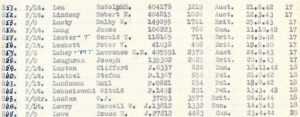
WWII, British and Allied Prisoners of War held in Germany, 1945: Flight Lieutenant Witold Łokuciewski was a prisoner of war in Stalag Luft 3, Sagan Belaria, Poland. Prisoner of war number: 291.
The Daily Telegraph, 6 July 1983: ‘Back to base. A SMALL photographic exhibition devoted to Gen. Skiorski, wartime leader of the Free Poles, has been mounted at the Polish Cultural Institute to complement the memorial lecture given on the 40th anniversary of his death by Gp Cap [Group Captain] Vitold Lokuciewski, whose choice as speaker was a particularly happy one.
In the Battle of Britain he flew with 303 Squadron from Northolt and won the DFC [Distinguished Flying Cross] for destroying nine enemy aircraft, with another three “probables,” before he was wounded and shot down in France in 1942.’
Bogusław Mierzwa (obscured in photo by Łokuciewski)
World War II Index to Allied Airmen Roll of Honour, 1939-1945: Pilot Officer Boguslaw Mierzwa was killed in action on 16 April 1941 while flying a Spitfire Mk. IIA. He was shot down by a Bf109 [Messerschmitt Bf 109 fighter aircraft] near the lighthouse at Dungeness, Kent when returning from an escort sortie to Berck-Sur-Mer. 22-year-old Mierzwa was buried in Northwood Cemetery. He was the holder of the Polish Cross of Valour with Bar.
Royal Air Force Operations Record Books: ‘16 April 1941. 16:30. Squadron acted as High escort to bombers. Circus [Fighter-escorted daylight bombing attacks against short-range targets with the aim of bringing the enemy air force to battle] attacked – on return journey the formation was attacked by a number of Me.109s, P/O Mierzwa crashed at Dungeness and was killed and P/O Waszkiewicz is missing. It is assumed that these aircraft were picked off individually.’
Find a Grave: Boguslaw Mierzwa, born 14 March 1918 in Warsaw, Mazowieckie, Poland, died 16 April 1941 in Kent, England. He is buried in Northwood Cemetery. Service Section H Grave 290. A photo of Mierzwa’s headstone accompanies his entry.
Zdzisław Henneberg
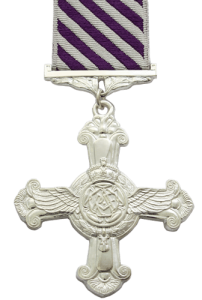
Royal Air Force Operations Record Books: ‘5 October 1940. 11:05. Combat over Rochester, Channel 11:40 hrs. 12 Hurricanes left Northolt 11:10 hrs. to rendezvous with No. 1 Canadian Squadron leading. 11 Hurricanes landed Northolt 12:20 – 13:10 hrs. The Wing flying Southward, met Enemy Fighters flying Northward to East of them over Rochester when the Squadron was at 18,000 ft…Me.109s descended from upper cloud in 5’s and 3’s. One Group of Me.109s turned 180 and attacked No. 1 Canadian Squadron and dived away Southwards. About 60 Enemy Aircraft and 40 Friendly Fighters were locked in running individual and section Dog Fights, rolling Southwards to the Channel. Over Lympne were about 15 Me.110s at about 20,000 ft., which formed a defensive circle, and there were great numbers of Me.109s above them and in the high clouds. Our aircraft attacked the circle singly from head on and below, and broke it up, inflicting heavy casualties in spite of attacks by Me.109s. Over the Channel, the Squadron was ordered home…F/O Henneberg destroyed one Me.109 but position of the crash not visible.’
World War II Index to Allied Airmen Roll of Honour, 1939-1945: Squadron Leader Henneberg was killed in action on 12 April 1941. The Officer Commanding 303 Squadron, his Spitfire Mk. IIA was damaged by flak over Berck-Sur-Mer airfield during a Rhubarb (low-level strike operation mounted in cloudy conditions against enemy targets in occupied countries). He baled out returning to England but was not recovered. Henneberg is commemorated on the Polish Air Force Memorial, Northolt.
Jan Rogowski
Jan Rogowski served with 303 Squadron during the Battle of Britain and later transferred to other RAF squadrons.
Royal Air Force Operations Record Books: ‘2 September 1940. 17:30. 12 Hurricanes left Northolt at 17:30 hrs. to intercept Raid No. 6 then Raid No. 17, then patrol Ashford. 11 Hurricanes landed Northolt 18:35 – 18:50 hrs…About 10 Me.109 dived out of sun on Squadron near Dover at 19,000 ft. Red Section were compelled to evade enemy and lost them. Sgt. Rogowski Green 3 persued 1 Me. 109, which crashed in the sea 10 miles from the French coast…’
WWII, Bomber and Fighter Command Losses, 1939-1945: Sergeant Rogowski of 74 Squadron was injured when his Spitfire Mk. II crashed at Eastbourne on 24 February 1941.
Eugeniusz Szaposznikow
After the war, Eugeniusz settled in England and changed his surname to Sharman.
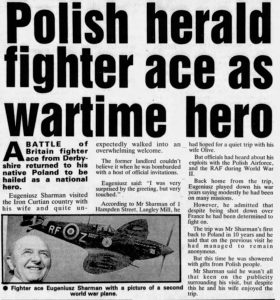
Royal Air Force Operations Record Books: ‘23 September 1940. 09:30. Combat Thames Estuary to Calais. 12 Hurricanes left Northolt 09:30 hrs. 12 Hurricanes landed Northolt 10:35 hrs. Squadron ordered Scramble base, and led No.1 Canadian Squadron and 229 Squadron as Wing. Vectored South of Biggin Hill and then towards Estuary. Saw about 20 streamers approaching from South. Squadron at 22,000 ft. then saw about 20 Me.109 at 30,000 to 25,000 ft. circling the Estuary. Wing circled slowly and enemy aircraft made no attempt to attack. Then about 12. Me.109 came from behind from some other formation apparently trying to break up the Wing. Red section attacked and E/A [Enemy Aircraft] fled Southwards…Sgt. Szaposznikow also overtook one Me.109 and shot it down in flames near French coast. Enemy planes made no attempt to fight Hurricanes and showed now aptitude for evasion…’
Derby Evening Telegraph, 11 November 1985: ‘A Battle of Britain fighter ace from Derbyshire returned to his native Poland to be hailed as a national hero. Eugeniusz Sharman visited the Iron Curtain country with his wife and quite unexpectedly walked into an overwhelming welcome.
The former landlord couldn’t believe it when he was bombarded with a host of official invitations.
Eugeniusz said: “I was very surprised by the greeting, but very touched…”’
Jan “Donald Duck” Zumbach
Royal Air Force Operations Record Books: ‘9 September 1940. 17:20. 12 Hurricanes left Northolt 17:25 hrs. Ordered to proceed South East. Ten Hurricanes landed 18:25 – 1900 hrs. Enemy met near Beachy Head at 18:00 hrs. about forty bombers Ju.88 [Junkers Ju 88 German aircraft], He.111 and Me.109 [and] Me.110 in large numbers. Enemy was escaping Southwards at great speed losing height. First seen when 1,000 ft. above Squadron and contacted by leading aircraft only at about 13,500 ft…F/O Zumbach was attacked by Me.109s. He destroyed one which disappeared in cloud and caught another banking in front of him, and fired into the cockpit, and engine from above at 30 yards seeing tracers hit…’
WWII, Bomber and Fighter Command Losses, 1939-1945: Pilot Officer Zumbach of 303 Squadron baled out of his Spitfire Mk. II over Dover on 9 May 1941. Fate: Safe.
The Daily Telegraph, 18 June 1990: ‘Fighter Aces. Leading Polish ace Witold Urbanowicz’s compatriots and fellow 303 Squadron pilots included Jan Zumbach, who racked up eight victories within three weeks in September [1940]…’
Cover image: ©IWM (CH 1535)
Sources
Royal Air Forces Register of Associations, Code Names and RAF Vocabulary, accessed July 2023.

